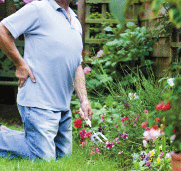Summer is finally here, and with it, a chance to make the most of the great outdoors. Unfortunately for us Chiropractors, it’s also a time when we see a large number of spinal injuries which affect the back, legs, shoulders and head.
My three-part series on summer health will help you take the strain out of the most notorious of summer leisure activities – Gardening, Sports & Exercise and Holidays.
Each summer sees the arrival of gardening season. At this time of year, I get a seasonal influx of patients with back and neck strain caused by over exertion in the garden. Regardless of how fit or physically active people are, gardening seems to bring out the weaknesses in our spines. As a result we see an increase in gardening-related spinal injury. Looking after your back properly before, during and after gardening activities will help sustain your health and fitness, and will ensure that you can garden successfully throughout the season.
Our body is incredibly adaptable, but it does weaken if not used (especially during the winter). So when we avoid the garden and turn instead to the fireplace, the muscles that support our spine can de-condition. As spring approaches, we begin to prepare the garden for our summer plants, and our spine unfortunately is not strong enough to cope with the excess load after hibernation. Once we do begin to work our body it will strengthen extremely quickly. The good news then, is that any strains that happen early in the season should not continue as the summer goes on. However, there are things that we can do in the garden to try to minimise the pressure placed in our backs.
Preparation
Fail to prepare, then prepare to fail. Preparation is key for all keen gardeners. The same is true for spinal care.
Designing your garden
When designing your garden, choose raised beds for low-maintenance planting. Invest in lifting trolleys and light-weight, long-handled tools. Work benches in sheds are a great idea as these will ease the strain of moving heavy sacks and are useful for potting plants.
Choosing your plants and containers
Plants that spread are ideal for easing your workload and save on bending and straining. They mean less weeding and less maintenance. Use bark and shingle for irrigation to assist with watering and to stifle those pesky weeds. Potting plants in large pots (these came in a range of colours and styles to brighten up your garden). Window containers will save on bending and digging, can be easily maintained and offer a splash of colour to your house.
Heavy gardening items
Bags of soil, shingle and other sack-filled items cause tension to the back, shoulders and knees from pulling and lifting. The very best way of transporting these heavier items is to use a wheelbarrow. Be sure to lift from a ‘squatting’ position and use your knees to stand upright. Avoid bending over at all costs. If you can, purchase these gardening items in smaller sacks or containers. Ask for a member of staff to assist you if your back is weak. Lifting with two people also distributes the weight – again, bend in the knees.
Digging
A simple warm-up before digging can do wonders. Start with some gentle exercises – Revolve the shoulders and stretch your arms above your head. Slowly rotate your head, first to one side, then in a circular motion. Stretch the legs and warm up the calf and thigh muscles. The hamstring and quadriceps are particularly weak, so spend at least ten minutes warming up the muscles before you begin gardening.
Chiropractic Tip! Get regular checks of your spine and seek advice from your chiropractor on suitable stretching and warm-up exercises.
When digging, keep calm and relaxed. Take your time and avoid pressurised over-exertion which increases tension and back strain. Use a spade which matches your height and size. If it feels too heavy, sway to a smaller one. Take regular breaks throughout and continue to do stretching exercises.
Don’t forget a bottle of water for dehydration!
Weeding and Planting
If you have not yet invested in a kneeling pad, then take a trip to B&Q or similar. Ones with side handles are best as you can use them to help you stand up using your knees. Position yourself as close as you can to the flower beds and use a long-handled, lightweight hoe. If kneeling, take regular breaks and stretch your legs.
Mowing
Of all the gardening tasks, mowing is likely to be the one you will do most often; before and after you start weeding and planting. Ensure that you have a suitable mowing machine for your lawn, ideally with an electric start and motorised wheels. Make sure you are aware of the type of grass you have before you buy a lawn mower, as this will help you chose the correct lawn mower for your lawn. Avoid swinging the mower. Instead move up and down the garden in lines and turn slowly to start the next line or section. Take regular breaks and drink plenty of water.
Pruning
Use secateurs which have a ‘cut and hold’ action, plus long-handled loppers when appropriate. Stand as close as you can to the shrubs and bushes, within a comfortable reaching distance. If using a ladder, prune in sections and move the ladder as you trim. Never over-reach.
Any more tips to add?
Enjoy a sensible summer, and if you do happen to experience any strain as a result of gardening, you can always give us a call at Optimal Chiropractic on 021 487 8465.













6 responses
Gardening does definitely seem to bring the any weakness in MY spine! The movements of gardening are unlike most of the movements that we tend to do during the long (Chicago area) winters. Thank you for the tips!
I tend to avoid the gardening, especially the weeding because afterwards my lower back aches for days. Love the idea of the containers – then you can bring them inside and keep changing them. Also great for if the weather turns, as you can bring them inside.
Great tips.
Awesome post. Bookmarked on Delicious 🙂
Thank you for this informative post. I’ll bookmark it.
Mark just sent this link my way, I really enjoyed the post – good reading! I expect your future stuff.